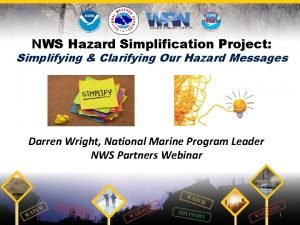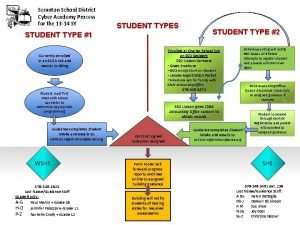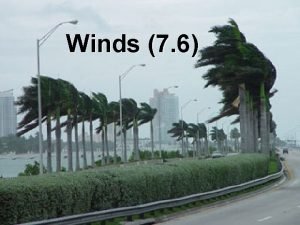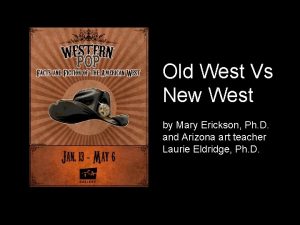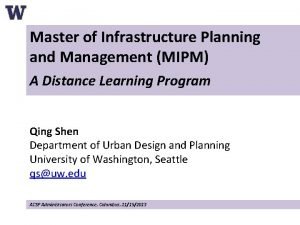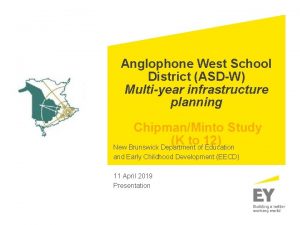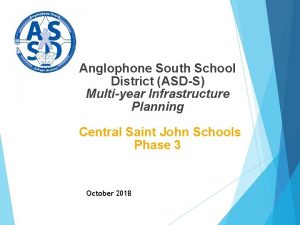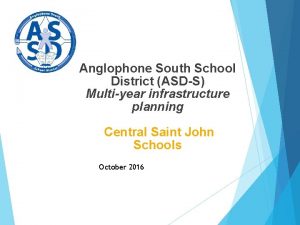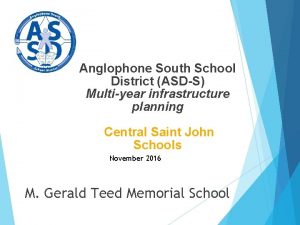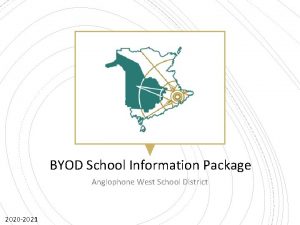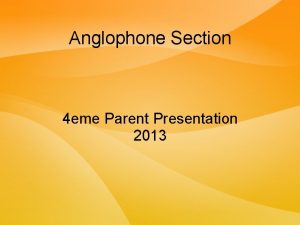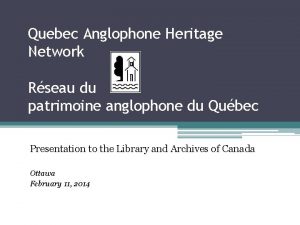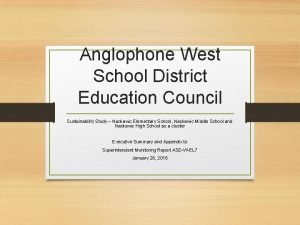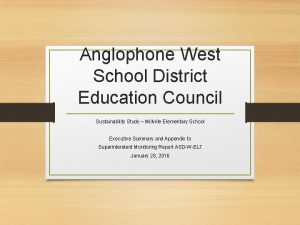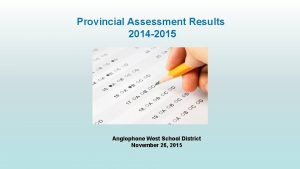Anglophone West School District ASDW Multiyear infrastructure planning













- Slides: 13

Anglophone West School District (ASD-W) Multi-year infrastructure planning Carleton North Drawing Area (K to 12) New Brunswick Department of Education and Early Childhood Development (EECD) 11 April 2019 Presentation

Scope – ASD-W has initiated a review of the six schools in the Carleton North drawing area to examine potential scenarios for long-term infrastructure planning Carleton North Feed Schools Subject schools – year built Florenceville Elementary School (K to 5 – 1966) Florenceville Middle School (6 to 8 – 1955) Considered a small middle school (< 300) Bristol Elementary School (K to 5 – 1966) Considered a small elementary school (< 200) Centreville Community School (K to 8 – 1952) Considered a small mixed school (< 300) Bath Community School (K to 8 – 1954) Considered a small mixed school (< 300) Note: Bath Community School was formed from an amalgamation of Bath Elementary School and Bath Middle School in 2015 -16. The school was undergoing a $4. 56 M renovation in 2018 (excluding the demolition costs of the elementary school or any of the proposed future site work – currently under review). Centreville Community School was initially built in 1952, and had a two-storey (4 classrooms) addition in 2003. Five out of six schools in the study are considered small by EECD Planning standards based on their total enrolment. Source: EECD sub-district map 2 for ASD-W, and 2018 EECD capital budget. Page 2 Carleton North High School (9 to 12 – 1977) Considered a small high school (< 500) Average of the subject infrastructure: 57 years Note: Early French Immersion (EFI) entry point is at Florenceville Elementary School and the Late French Immersion (LFI) entry point is at Florenceville Middle School.

Scope – Consultations between the District and EY narrowed the scope to six potential scenarios to be summarized for the infrastructure review (1/3) The following scenarios were included within the scope of the Carleton North drawing area infrastructure planning review. Each scenario was based on space requirements identified in the EECD Planning Guidelines for Educational Facilities, with enrolment projections for the schools developed by mapping 2016 Census data (Statistics Canada) to the school boundaries in order to determine future space requirements: § Scenario 1: Close Florenceville Elementary, Florenceville Middle School, and Bristol Elementary schools. Replace them with a new K-5 elementary school (321 combined student enrolment in 2017 -18) and re-configure Carleton North High School to a 6 -12 school. Determine what renovations/additions would be required based on the EECD Planning Guidelines for Educational Facilities (648 combined 6 -12 student enrolment in 2017 -18). Develop a Class “D” (± 30%) estimate for the construction costs of the new school/renovations. § Scenario 2: Close Florenceville Elementary, Florenceville Middle School, Centreville Community School, and Bristol Elementary School. Replace them with a new K-5 elementary school (458 combined student enrolment in 2017 -18) and re-configure Carleton North High School to a 6 -12 school. Determine what renovations/additions would be required based on the EECD Planning Guidelines for Educational Facilities (696 combined 6 -12 student enrolment in 2017 -18). Develop a Class “D” (± 30%) estimate for the construction costs of the new school/renovations. Page 3 Note: Construction estimates in the report are for planning purposes only to be used in scenario comparison. Actual costs can be wide-ranging depending on soft costs (design work, real estate costs, project management, etc. ), size, topography, geotechnical engineering, and other existing conditions. Estimates are considered class “D” (± 30%) estimate for the construction costs of the new schools based on the space requirements identified in the EECD Planning Guidelines for Educational Facilities.

Scope – Consultations between the District and EY narrowed the scope to six potential scenarios to be summarized for the infrastructure review (2/3) § Scenario 3: Close Florenceville Elementary, Florenceville Middle School, and Bristol Elementary School. Replace them with a new K-8 school (528 combined student enrolment in 2017 -18) and plan for mid-life upgrade of Carleton North High School based on the structural review recommendations (school remains 9 -12 school with 441 students based on enrolment in 2017 -18, with a potential of a school wing closure). Develop a Class “D” (± 30%) estimate for the construction costs of the new school/renovations. § Scenario 4: Close Florenceville Elementary, Florenceville Middle School, Centreville Community School, and Bristol Elementary School. Replace them with a new K-8 school (713 combined student enrolment in 2017 -18) and plan for mid-life upgrade of Carleton North High School based on the structural review recommendations (school remains 9 -12 school with 441 students based on enrolment in 2017 -18, with a potential of a school wing closure). Develop a Class “D” (± 30%) estimate for the construction costs of the new school/renovations. Page 4 Note: Construction estimates in the report are for planning purposes only to be used in scenario comparison. Actual costs can be wide-ranging depending on soft costs (design work, real estate costs, project management, etc. ), size, topography, geotechnical engineering, and other existing conditions. Estimates are considered class “D” (± 30%) estimate for the construction costs of the new schools based on the space requirements identified in the EECD Planning Guidelines for Educational Facilities.

Scope – Consultations between the District and EY narrowed the scope to six potential scenarios to be summarized for the infrastructure review (3/3) § Scenario 5: Close Florenceville Elementary, Florenceville Middle School, Centreville Community School, Bath Community School, and Bristol Elementary School. Replace them with a new K-5 elementary school (559 combined student enrolment in 2017 -18) and re-configure Carleton North High School to a 6 -12 school. Determine what renovations/additions would be required based on the EECD Planning Guidelines for Educational Facilities (768 combined 6 -12 student enrolment in 2017 -18). Develop a Class “D” (± 30%) estimate for the construction costs of the new school/renovations. § Scenario 6: Close Florenceville Elementary, Florenceville Middle School, Centreville Community School, Bath Community School, and Bristol Elementary School. Replace them with two new K-8 schools (886 combined student enrolment in 2017 -18 split between the two schools). Plan to have a mid-life upgrade of Carleton North High School based on the structural review recommendations (school remains 9 -12 school with 441 students based on enrolment in 2017 -18 with a potential of a school wing closure). Develop a Class “D” (± 30%) estimate for the construction costs of the new school/renovations. (Note: upon review of enrolment projection numbers- Scenario 6 was changed to one new K-8 and a mid-life upgrade of Carleton North High School). § Determine the pros and cons of each scenario considering both pedagogical and fiscal requirements. Page 5 Note: Construction estimates in the report are for planning purposes only to be used in scenario comparison. Actual costs can be wide-ranging depending on soft costs (design work, real estate costs, project management, etc. ), size, topography, geotechnical engineering, and other existing conditions. Estimates are considered class “D” (± 30%) estimate for the construction costs of the new schools based on the space requirements identified in the EECD Planning Guidelines for Educational Facilities.

Overview of feed schools in the Carleton North Catchment Area – Existing school boundaries ou ton C Carle NB-560 nty Lin e NB -5 65 e Lin ty un rle Ca NB-107 NB-580 ay iver hn R 60 ighw a. H d ana t Jo ns-C Sain Tra n NB-5 stow m Willia Lake 50 NB-5 4 -10 NB Source: ASD-W school transportation software - Busplanner. Page 6 NB-570 30 -1 NB 50 NB-5 Florenceville Elementary School Boundary 5 -10 03 NB NB-1 Centreville Community School Boundary Juniper NB-580 NB-107 NB-570 10 0 ay -1 60 NB Bristol Elementary School Boundary 13 ighw NB da H ana NB-107 NB-5 United States Border 05 Co NB -1 ton ns-C Tra Bath Community School Boundary + Florenceville Middle School Boundary Carleton North High School Boundary Bristol Elementary School Florenceville Middle School Carleton North High School Centreville Community School Bath Community School

2016 Census data – Florenceville-Bristol schools projected to see a decrease in enrolment (based on the population age grouping census data), excluding any net migration (2 of 2) Data for Florenceville-Bristol (T), Peel (P), Simonds (P) and Aberdeen (P) census profiles: Boundary for Florenceville-Bristol (T) Aberdeen Parish, P on m Si ds United States Peel Parish, P h, ris Pa P ► Enrolment decrease has come from the birth decline in both the surrounding parishes and Florenceville-Bristol town. The largest birth decline is between the 5 to 9 and the 10 to 14 age groups. ► Vital statistics and census data indicates the enrolment will trend downwards for K-8 in the Florenceville-Bristol schools (excluding any net migration). Source: Statistics Canada. 2017. Florenceville-Bristol, T [Census subdivision], Peel, P [Census subdivision], Simonds, P [Census subdivision], New Brunswick, Aberdeen, P [Census subdivision], New Brunswick and Carleton, CT [Census division], New Brunswick (table). Census Profile. 2016 Census. Statistics Canada Catalogue] no. 98 -316 -X 2016001. Ottawa. Released November 29, 2017. Page 7

2016 Census data – Centreville Community School projected to see a decrease in enrolment (based on the population age grouping census data), excluding any net migration (2 of 2) Data for Centreville (VL), Wicklow (P) and Wilmot (P) census profiles: Boundary for Centreville (VL) Wicklow Parish, P United States Wi lmo t. P ari sh, P ► Centreville Community School enrolment trend expected to decline, when the parishes of Wicklow and Wilmot are included in the five-year age group trending. ► However, the vital statistics and census data indicates a downward trend in enrolment for K-8 in the Centreville Community School boundary (excluding any net migration). Source: Statistics Canada. 2017. Centreville, VL [Census subdivision], Wicklow, P [Census subdivision], Wilmot, P [Census subdivision], New Brunswick and Carleton, CT [Census division], New Brunswick (table). Census Profile. 2016 Census. Statistics Canada Catalogue no. 98 -316 -X 2016001. Ottawa. Released November 29, 2017. Page 8

2016 Census data – Bath Community School projected to see a decrease in enrolment (based on the population age grouping census data), excluding any net migration (2 of 2) Data for Bath (VL), and Kent (P) census profiles: Boundary for Bath (VL) P h, nt Ke is ar P United States ► The vital statistics and census data indicates that the K-8 enrolment will continue to trend downwards in the Bath Community School boundary (excluding any net migration). Source: Statistics Canada. 2017. Bath, VL [Census subdivision], Kent, P [Census subdivision], New Brunswick and Carleton, CT [Census division], New Brunswick (table). Census Profile. 2016 Census. Statistics Canada Catalogue no. 98 -316 -X 2016001. Ottawa. Released November 29, 2017. Page 9

Mapping 2016 Census data – Total enrolment for K-12 in the Carleton North catchment area is projected to continue downward based on census mapping and vital statistics ► Note: The Census data quality reported by Statistics Canada of 3. 4% to 4. 5% for Carleton County (was rounded to +/-2. 5%) and used to project the upper and lower limits in the enrolment projections. Source: Statistics Canada. 2017. Carleton, CT [County Census subdivision], New Brunswick and New Brunswick (table). Census Profile. 2016 Census. Statistics Canada Catalogue no. 98 -316 -X 2016001. Ottawa. Released November 29, 2017, Service New Brunswick, Vital Statistics, Table 2 A: Vital Statistics by County of Residence, Page 10 New Brunswick (1998 -2017), Fredericton, NB, and ASD-W 2010 -2018 enrolment data.

Scenarios 1, 2 and 5 which include a re-configuration and mid-life upgrade of Carleton North High School to 6 -12 are deemed unviable due to high cost; would require a new 6 -12 Ma in et re St ► Although Carleton North High School was built for a larger capacity than current enrolments (681 in 2000 and 434 in 2018), there are not enough general classrooms to add the middle school program into the existing school based on the curriculum. Each of scenarios 1, 2 and 5 would require an addition to the school. Additionally, some of the vocational shop space may be converted into middle school space as well. ► A building assessment performed for DTI estimated that option B mid-life upgrade for Carleton North High School including priority 1 – immediate repairs, priority 2 – repairs within the next 10 years with classroom refurbishment would be $27. 0 M*. ► All three scenarios were deemed unviable with the re-configuration, as the estimated costs were more than 75% of the replacement cost for the same sized building area. Therefore, K-5 / 6 -12 scenario would require two new schools. *Note: Class "D" estimate (± 30%) based on the EECD Planning Guidelines for Educational Facilities, as an estimate for this report only. Estimates will be adjusted when EECD Infrastructure and the project team establish the actual space allocation. Page 11

Scenarios 3, 4 and 6 which include a mid-life upgrade of Carleton North High School are deemed viable as they are < 75% of the replacement costs of the high school area Ma in et re St ► ► Scenarios 3, 4, and 6 keep Carleton North classified as high school (9 -12). There is a possibility that general classrooms could be closed/removed from the school during a mid-life upgrade in order to match the classroom specifications of the EECD Planning Guidelines. The reduction would depend on if and when a mid-life upgrade is scheduled. One community group has made a presentation in 2018 to the DEC requesting a new K-8 school be constructed next to Carleton North High School to develop a shared learning campus. (Centreville and Bath were not included in this group). A building assessment performed for DTI estimated that option A mid-life upgrade for Carleton North High School including priority 1 – immediate repairs, priority 2 – repairs within the next 10 years with some classroom demolition would be $24. 0 M*. All three scenarios were deemed viable with a mid-life upgrade, as the estimated costs were less than 75% of the replacement cost for the same sized building area. *Note: Class "D" estimate (± 30%) based on the EECD Planning Guidelines for Educational Facilities, as an estimate for this report only. Estimates will be adjusted when EECD Infrastructure and the project team establish the actual space allocation. Page 12

EY | Assurance | Tax | Transactions | Advisory About EY EY is a global leader in assurance, tax, transaction and advisory services. The insights and quality services we deliver help build trust and confidence in the capital markets and in economies the world over. We develop outstanding leaders who team to deliver on our promises to all of our stakeholders. In so doing, we play a critical role in building a better working world for our people, for our clients and for our communities. EY refers to the global organization, and may refer to one or more, of the member firms of Ernst & Young Global Limited, each of which is a separate legal entity. Ernst & Young Global Limited, a UK company limited by guarantee, does not provide services to clients. For more information about our organization, please visit ey. com. © 2019 Ernst & Young LLP. All Rights Reserved. A member firm of Ernst & Young Global Limited. This publication contains information in summary form, current as of the date of publication, and is intended for general guidance only. It should not be regarded as comprehensive or a substitute for professional advice. Before taking any particular course of action, contact Ernst & Young or another professional advisor to discuss these matters in the context of your particular circumstances. We accept no responsibility for any loss or damage occasioned by your reliance on information contained in this publication. ey. com/ca/private
 Anglophone south school district
Anglophone south school district Powerschool nbed anglophone west
Powerschool nbed anglophone west Asdw simplification
Asdw simplification Anglophone caribbean
Anglophone caribbean Lodi unified summer school
Lodi unified summer school Iswk school uniform
Iswk school uniform Scranton cyber academy
Scranton cyber academy West kowloon cultural district master plan
West kowloon cultural district master plan West north west wind direction
West north west wind direction What creates wind
What creates wind Oost noord zuid west
Oost noord zuid west East is east and west is west
East is east and west is west Old west vs new west
Old west vs new west Masters in infrastructure planning and management
Masters in infrastructure planning and management


